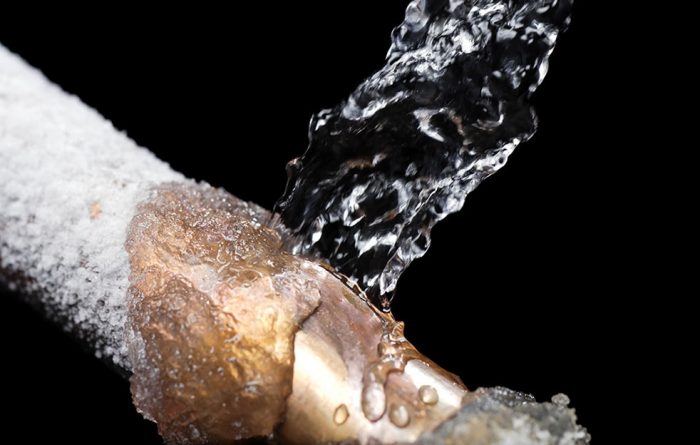In the Yukon and Oklahoma City area, winter temperatures can drop low enough for the water lines in your home or business to freeze.
What Happens When a Water Pipe Freezes
How do you tell if your water line has frozen? If the outside temperature is below freezing and you can only get a small amount of water out of your faucet, you probably have a frozen pipe.
If you’re lucky, the pipe will thaw before further damage is done. Unfortunately, sometimes this doesn’t happen, and the pipe breaks.
This is because the ice inside the pipe tries to expand and increases pressure in the pipe. This pressure pushes water toward the faucet. Since the faucet is closed, the pressure between the ice and the faucet builds until the pipe bursts.
A broken water pipe can cause thousands of dollars worth of damage before it’s even noticed. That’s why it’s so important to prevent water lines from freezing, and to carefully thaw pipes if they do freeze.

How to Prevent Frozen Water Lines
If you have areas in and around your home where pipes are exposed to the elements, or where your heating system can’t reach, you can take some steps to prevent freezing.
Insulate Pipes
You can insulate water pipes that are exposed to the outdoors, and those in unheated parts of your home to prevent freezing. Foam insulating sleeves can be purchased at most hardware stores for this purpose. In a pinch, you can also use carefully wrapped towels and blankets. If the pipe is outdoors, make sure to also use some kind of waterproof covering to make sure your coverings don’t get wet. E.g. a plastic trash can or tarp. Be cautious of nearby fire hazards and other dangers if you wrap a pipe.
Use a Heat Tape or a Pipe Heater
Heat tape and pipe heaters are not a long-term solution, but they do offer quick protection from a freeze. These products are applied heat directly to your water lines to create and retain heat. Also available at hardware stores, these products are safe and effective when used properly. If you have frequent freezing, you may consider more long-term solutions.
Add Insulation
This is a bigger and more expensive project, but typically the best and most permanent fix. Improving the insulation in the areas where the pipes are housed will ensure temperatures remain above freezing. This could mean adding wall insulation, enclosing outdoor pipes, improving doors and/or windows, and making sure the flooring and roofing are well insulated. If insulation isn’t possible, you may need to consider having a plumber move the pipes, so they aren’t exposed to the cold.
Let the Heat Into Cabinets, Closets and Cold Rooms
If you have pipes in cold rooms, closets and cabinets, leave the doors open so that warm are can reach the pipes. You can also use space heaters as a short-term fix. More warm air in cold areas can prevent water from freezing.
Let Faucets Drip
Allowing faucets to drip in areas where you know pipes are prone to freezing can keep water circulating and prevent pressure from building up in the lines. This will reduce the risk of a freeze.
Many people let all of their faucets drip a small amount when temperatures are extremely low. This is really only necessary if you have pipes that are exposed outdoors, or areas inside your home that you know get below freezing.
Pipe Thawing
If a pipe in your home freezes, the first thing to do is keep the affected faucet open. Letting water run through will help melt the ice and reduce the amount of pressure that builds up.
Freezing often happens along exterior walls or near your home’s foundation, so if you can’t find or access the blockage it’s best to call a plumber. If you can find the frozen area of the pipe, however, you can apply heat to thaw it.
A hair dryer or heating pad will provide direct heat, or you can use a space heater to warm the whole room. Don’t use any type of heating source with an open flame, like a blowtorch or propane heater. Once your faucet returns to full water pressure, you’ll know your pipe is thawed.
In the unfortunate event that a pipe breaks, our technicians can quickly repair it and get your water back on.
